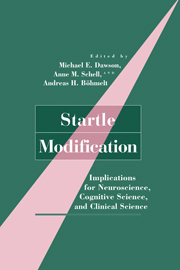Book contents
- Frontmatter
- Contents
- Contributors
- Preface
- Prologue: A Historical Note on the “Discovery” of Startle Modification
- 1 Startle Modification: Introduction and Overview
- PART I BASIC PARADIGMS, METHODS, AND PHENOMENA
- PART II PHYSIOLOGICAL MEDIATION OF STARTLE MODIFICATION
- PART III PSYCHOLOGICAL MEDIATION OF STARTLE MODIFICATION
- PART IV INDIVIDUAL DIFFERENCES AND STARTLE MODIFICATION
- PART V RELATIONSHIPS WITH OTHER PARADIGMS AND MEASURES
- References
- Author Index
- Subject Index
Prologue: A Historical Note on the “Discovery” of Startle Modification
Published online by Cambridge University Press: 26 March 2010
- Frontmatter
- Contents
- Contributors
- Preface
- Prologue: A Historical Note on the “Discovery” of Startle Modification
- 1 Startle Modification: Introduction and Overview
- PART I BASIC PARADIGMS, METHODS, AND PHENOMENA
- PART II PHYSIOLOGICAL MEDIATION OF STARTLE MODIFICATION
- PART III PSYCHOLOGICAL MEDIATION OF STARTLE MODIFICATION
- PART IV INDIVIDUAL DIFFERENCES AND STARTLE MODIFICATION
- PART V RELATIONSHIPS WITH OTHER PARADIGMS AND MEASURES
- References
- Author Index
- Subject Index
Summary
The term startle modification refers to the change in the amplitude and/or the latency of a startle reaction when the startle-eliciting signal has been preceded or accompanied by another (usually weaker) stimulus. In the early 1960s my students and I discovered or, as will be seen, rediscovered these effects when we found that in rats, the startle reaction to a sudden explosive sound could be virtually eliminated if another, barely audible, sound precedes the intense sound by about a tenth of a second (Hoffman and Searle 1965). We found this effect to be so impressive that we began what has for us proven to be more than 30 years of continuing investigations of its basic features.
At the time we started that work, very little of the contemporary research involved startle, and the primary source on this reaction was a slim volume entitled The Startle Pattern by Carney Landis and William A. Hunt (1939). This book described an extensive series of investigations by the authors in which high-speed cinematic photographs of both animal and human startle reactions were carefully analyzed. It is significant that the book made no mention of the phenomenon of startle modification, nor had the phenomenon been noted in any of the more contemporary research literature we were examining at the time.
It was a number of years after we had “discovered” startle modification that we were to learn that James Ison at the University of Rochester had independently and almost simultaneously discovered the same phenomenon. Furthermore, Ison's subsequent historical studies revealed that the phenomenon was originally discovered by Sechenov, a Russian scientist, almost 100 years earlier (Sechenov 1863/1965).
- Type
- Chapter
- Information
- Startle ModificationImplications for Neuroscience, Cognitive Science, and Clinical Science, pp. 1 - 5Publisher: Cambridge University PressPrint publication year: 1999



